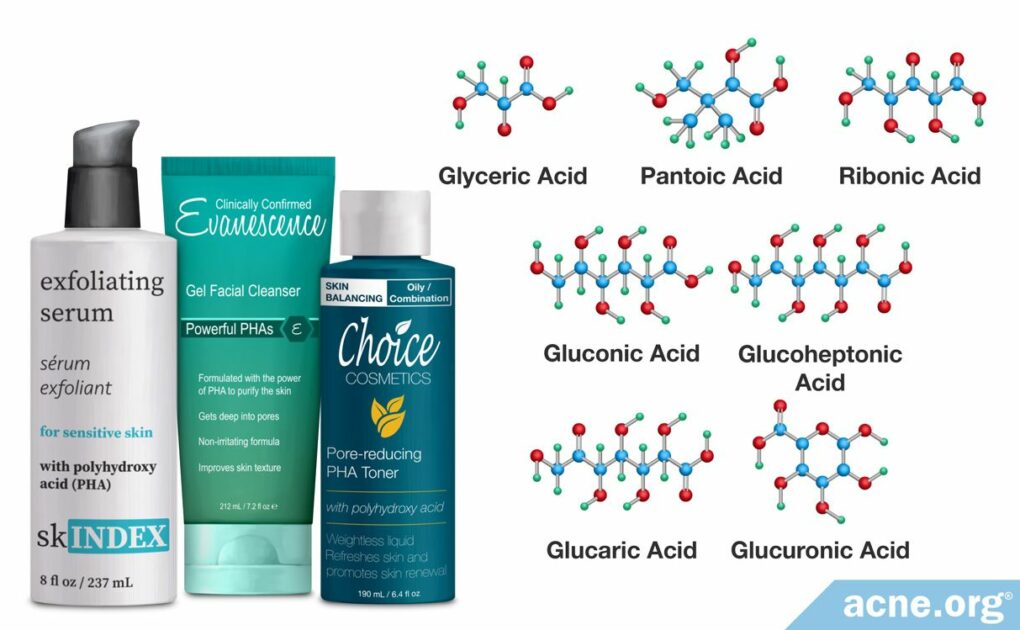Polyhydroxy Acids May Work to Clear Acne a Small Amount by Exfoliating the Surface of the Skin, Increasing Antioxidants, Increasing Skin Moisture, Decreasing Hyperpigmentation, and Promoting the Penetration of Acne Medications

The Essential Info
Polyhydroxy acids are a group of acids that are used to treat a variety of skin conditions. They are hydroxy acids like alpha hydroxy acids and beta hydroxy acids, but their unique chemical makeup leads the skin to absorb them more slowly, thus reducing side effects.
They may be somewhat useful in treating acne through their ability to:
- Exfoliate the surface of the skin
- Increase antioxidants in the skin
- Increase skin moisture
- Promote the penetration of acne medications
However, only one study to date has studied topical polyhydroxy acids on people with acne. It showed a 20% clearing of acne. Therefore, if polyhydroxy acids can in fact help reduce acne, it is likely to a minor degree. For this reason, they should be used alongside other acne medications.
Polyhydroxy acids may also help with the appearance of skin by reducing skin discoloration, and decreasing signs of aging.

The Science
- Introduction to Polyhydroxy Acids
- Types of Polyhydroxy Acids
- How Polyhydroxy Acids Work to Clear Acne
- Anti-aging Effects
- Polyhydroxy Acid Treatments for Acne
- Polyhydroxy Acid Side Effects
- Effects of Polyhydroxy Acids on the Skin and on Acne
Introduction to Polyhydroxy Acids
Polyhydroxy acids are a group of acids used to treat skin conditions like dry skin, rosacea, warts, eczema, psoriasis, skin aging, and potentially acne.
Polyhydroxy acids differ from alpha hydroxy acids (AHAs) and beta hydroxy acids (BHAs) because they:
- Can act as antioxidants: Antioxidants are substances that absorb skin-damaging oxidants. People with acne often have increased levels of oxidants that can damage the skin, so the antioxidant properties of polyhydroxy acids may help counteract their effects.
- Cause fewer side effects: Polyhydroxy acids have a unique chemical structure, and this structure causes them to be absorbed by the skin more slowly. This causes them to produce less irritation than AHAs and BHAs.
- Increase the amount of hyaluronic acid in the skin: Hyaluronic acid is an important substance found in the skin that helps the skin to retain water and prevent it from drying out. Scientists consider polyhydroxy acids “next generation” AHAs because polyhydroxy acids increase the amount of hyaluronic acid in the skin, helping to keep the skin hydrated.
Researchers have only performed one study that investigated the effectiveness of topical polyhydroxy acids on acne, and this study found that these acids reduced acne by only 20%. Therefore, polyhydroxy acids should be used in combination with other acne medications.1-3
Types of Polyhydroxy Acids
There are several types of polyhydroxy acids used to treat the skin, including glyceric acid, pantoic acid, ribonic acid, gluconic acid (galactonic acid), glucoheptonic acid, glucaric acid (saccharic acid), and glucuronic acid (galactoronic or iduronic acid).
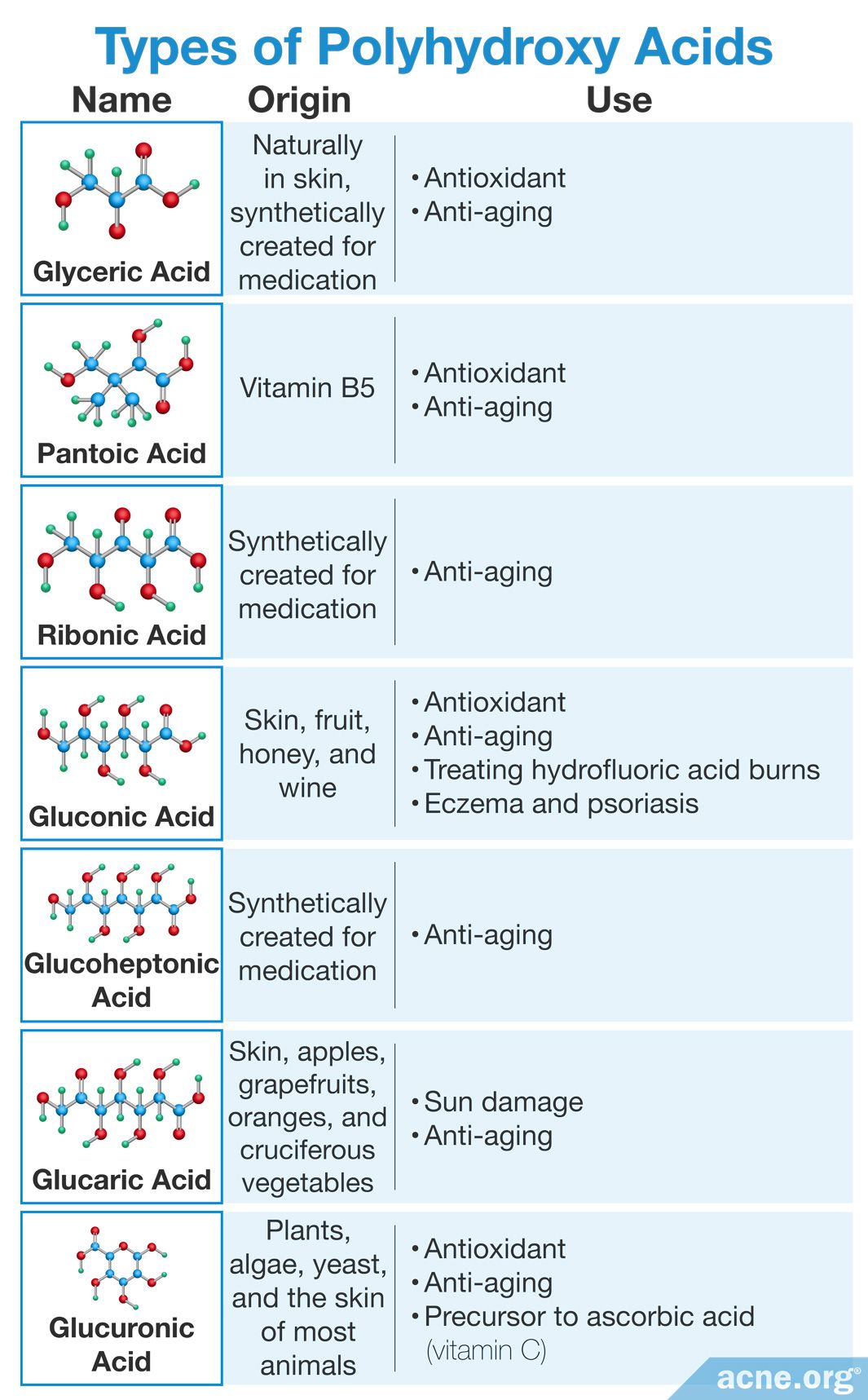
How Polyhydroxy Acids Work to Clear Acne
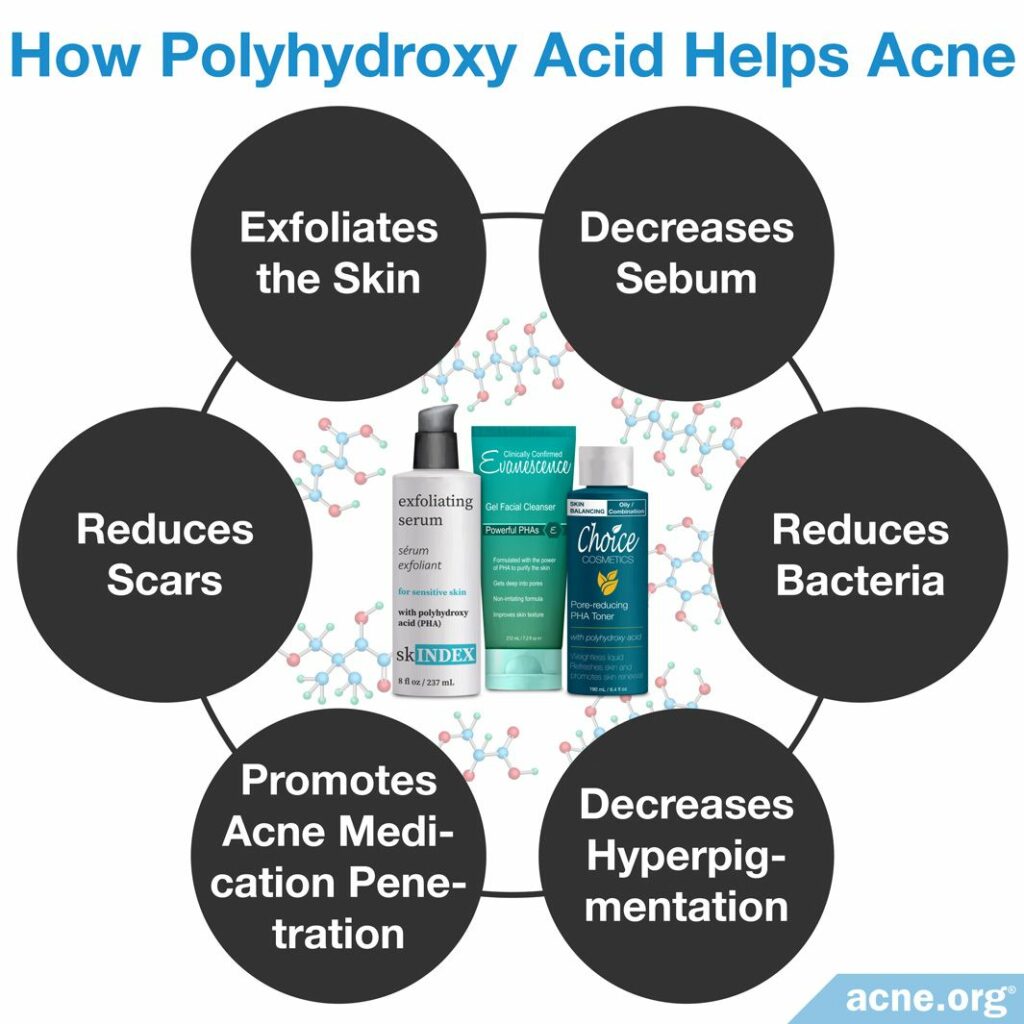
Very little is known about how polyhydroxy acids may affect acne. Instead, researchers have used studies of polyhydroxy acids on other skin conditions to create a list of effects polyhydroxy acids have on the skin, and then used these characteristics to predict how they may work to clear acne. The effects polyhydroxy acids have on the skin include:
- Exfoliate the skin: In normal skin, there is a constant state of renewal in which dead skin cells called corneocytes flake off the surface of the skin, and new skin cells take their place. If this renewal process is disturbed, which occurs in acne-prone skin, then a layer of corneocytes accumulates on the surface of the skin. This accumulation can lead to clogged pores and acne. Polyhydroxy acids work to break apart these corneocytes by breaking down skin cells called keratinocytes, which produce the “sticky” protein keratin and are more abundant in people with acne-prone skin. Keratin works like glue to stick the corneocytes together, and polyhydroxy acids can break down this keratin to help “pull” these dead skin cells apart. This helps to exfoliate the skin by removing the layer of dead skin cells, which helps to unclog pores and prevent acne.
- Increase antioxidants: Oxidants are toxic chemicals that can damage skin cells and cause inflammation of the skin. Antioxidants fight oxidants and can prevent the damage that they cause. Polyhydroxy acids are antioxidants, which means they reduce the number of harmful oxidants in the skin. Two main antioxidants are vitamins C and E, and polyhydroxy acids possess antioxidant properties comparable to both these vitamins. Antioxidants are an important factor in the treatment of acne because they help to protect skin cells from damage and inflammation, which can trigger acne development and make acne worse.
- Increase skin moisture: To remain healthy, the skin must contain a certain amount of water to avoid drying out and becoming flaky or crusty.4 Acne treatments often dry out the skin, but polyhydroxy acids work to replenish the moisture in the skin by increasing the amount of hyaluronic acid in the skin. Hyaluronic acid works by retaining water inside the skin, which helps keep the skin plump and prevents it from drying out. One polyhydroxy acid, called glucuronic acid, is one of the two major components of hyaluronic acid and, as such, helps to retain hyaluronic acid in the skin and keep the skin hydrated. The effect of polyhydroxy acids on the skin makes scientists consider them “next generation” alpha hydroxy acids.
- Reduce skin discoloration: Several factors can cause skin discoloration, including too much exposure to the sun, skin damage, or acne. These factors can cause the skin to become discolored with red/dark marks called post-inflammatory hyperpigmentation, or just hyperpigmentation for short. Polyhydroxy acids may help to decrease hyperpigmentation because they can increase the rate of skin cell growth. As the skin produces more normal-looking cells, new cells replace old, discolored cells and help restore the skin’s natural hue.
- Promote the penetration of acne medications: Polyhydroxy acids work by exfoliating the surface of the skin. This helps skin or acne medications like benzoyl peroxide be more effective by making it easier for those medications to penetrate deeper into the skin.
Anti-aging Effects
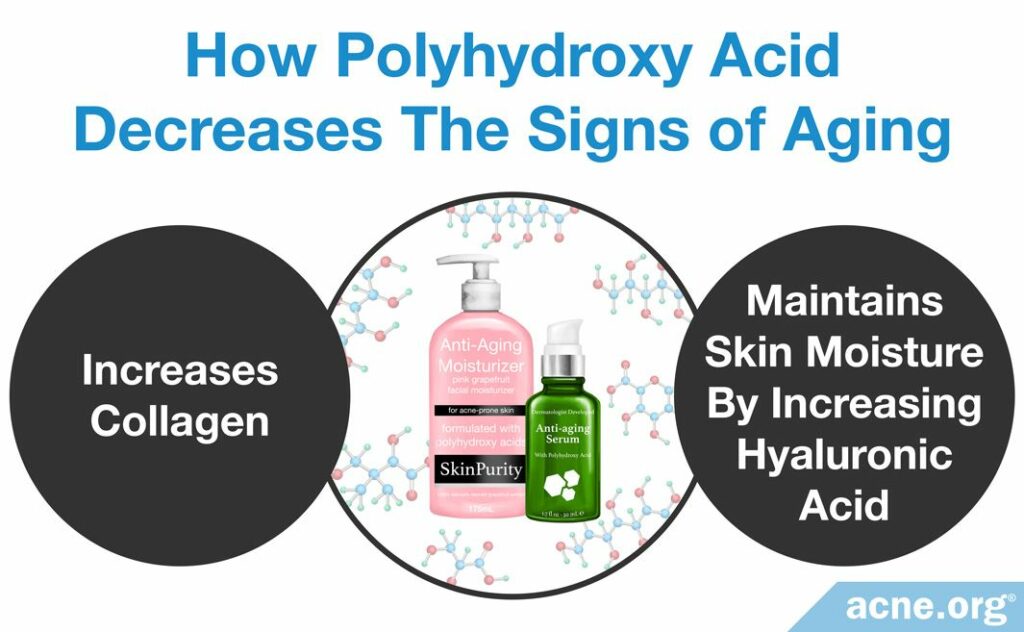
Polyhydroxy acids work to decrease the signs of aging by:
- Increasing the amount of collagen in the skin: Collagen gives structure to the skin. If the amount of collagen decreases, a sunken look with wrinkles results. Polyhydroxy acids may increase the amount of collagen in the skin, therefore promoting a healthy skin appearance and decreasing the signs of aging.
- Increasing the production of new skin cells: The production of new skin cells helps the skin to appear thicker and plumper.1,2,5-7
Polyhydroxy Acid Treatments for Acne
Polyhydroxy acids are available in over-the-counter (OTC) products and professionally-administered chemical peels.
Over-the-counter products
Normally, the Food and Drug Administration (FDA) sets guidelines regarding the concentrations of hydroxy acids in over-the-counter products, but there is no official FDA recommendation regarding concentrations of polyhydroxy acids in over-the-counter products. However, there are over-the-counter products that contain 15% gluconolactone, so the concentration in OTC products is at least up to 15%. This 15% concentration is higher than what the guidelines for other acids allow, so consumers should be cautious and start with lower concentrations before using products with higher concentrations.
Professionally-administered peels
Like with the OTC products, there are no FDA guidelines regarding the concentration of polyhydroxy acids in professionally-administered peels. Generally, chemical peels contain a higher concentration than OTC products, so it is likely that a polyhydroxy acid peel will also contain concentrations of polyhydroxy acid higher than the 15% found in some OTC products.
Polyhydroxy Acid Side Effects
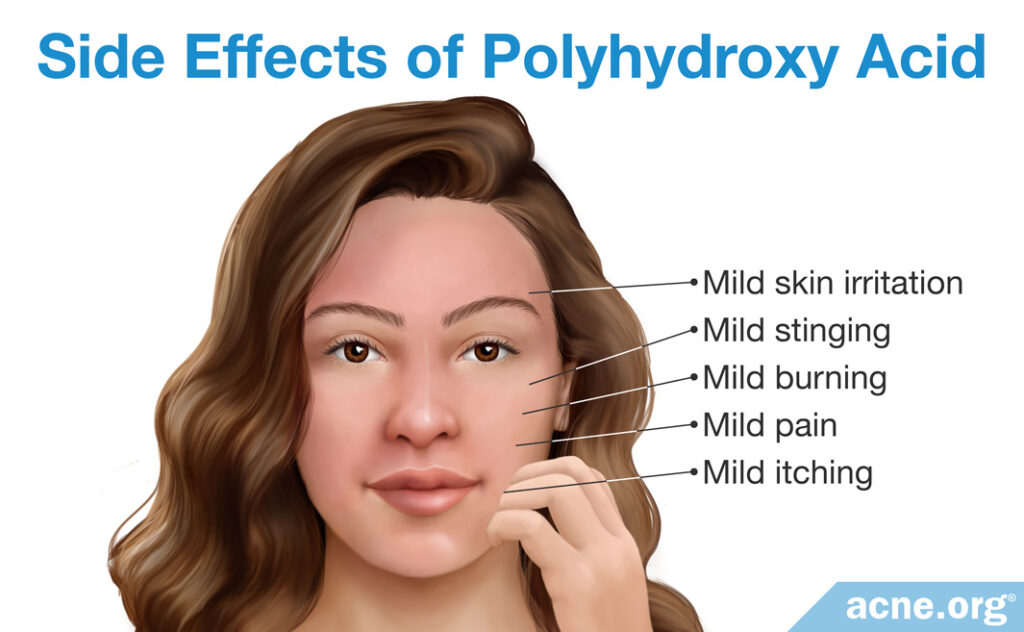
Polyhydroxy acids, because of their chemical structure, are absorbed by the skin more slowly. Since they are absorbed slowly, they are gentler than AHAs and BHAs. This means that polyhydroxy acids cause fewer and milder side effects and can be tolerated by people who may not be able to tolerate AHAs and BHAs.3
Common side effects of polyhydroxy acid skin treatments include:
- Skin irritation
- Burning
- Stinging
- Mild pain
- Itching
Sun sensitivity
Polyhydroxy acids do not appear to increase sensitivity to the sun.
Effects of Polyhydroxy Acids on the Skin and on Acne
Most research investigating the effect of polyhydroxy acids has focused on their ability to treat other conditions, such as eczema, psoriasis, dry skin, rosacea, and skin aging. These studies have found that 10 – 15% gluconolactone, combined with corticosteroids, is especially effective at treating eczema and psoriasis.
Additionally, polyhydroxy acids, combined with AHAs, are effective in the treatment of dry skin and rosacea.
Polyhydroxy acids can also treat the signs of aging at 10 – 15% concentrations, and are as effective as AHAs, with fewer side effects.
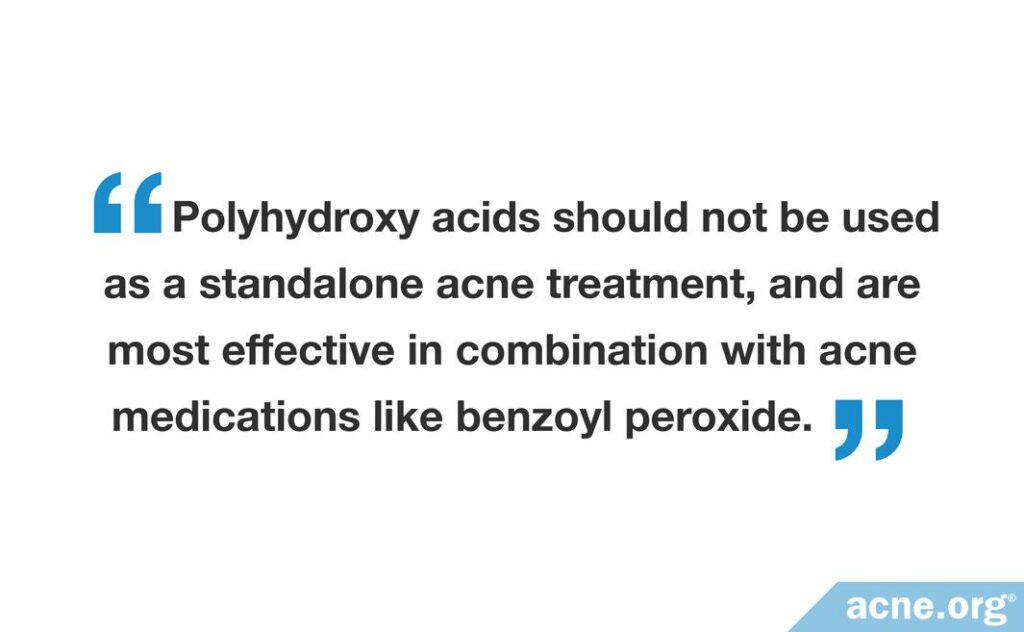
When it comes to acne, researchers have only performed two studies testing polyhydroxy acids as an acne treatment–one with oral glucuronic acid, and one with topical gluconolactone.

The first study, published in the Tohoku Journal of Experimental Medicine way back in 1956, treated 27 acne patients with oral glucuronic acid. The researchers gave the patients 3 g of glucuronic acid by mouth three times a day and also administered 400 mg of glucuronic acid by injection. After 3 months of treatment with oral glucuronic acid, the researchers reported a complete clearing of acne in 52% of the patients and “highly satisfactory results” in 26% of the patients.8

The second study, published in the Australasian Journal of Dermatology in 1992, looked at the effectiveness of topical 14% gluconolactone on 150 acne patients. The researchers found that topical gluconolactone reduced mild-to-moderate acne by about 20% over 12 weeks. However, the researchers stated that gluconolactone should not be used as a standalone treatment, and would be most effective as an acne treatment in combination with acne medications like benzoyl peroxide.9
References
- Yu, R. J. & Van Scott, E. J. Alpha-hydroxyacids and carboxylic acids. J Cosmet Dermatol 3, 76 – 87 (2004). https://www.ncbi.nlm.nih.gov/pubmed/17147560
- Green, B. After 30 years … the future of hydroxyacids. J Cosmet Dermatol 4, 44 – 45 (2005). https://www.ncbi.nlm.nih.gov/pubmed/17134422
- Decker, A. & Graber, E. M. Over-the-counter acne treatments: A review. J Clin Aesthet Dermatol 5, 32 – 40 (2012). https://www.ncbi.nlm.nih.gov/pubmed/22808307
- Jarząbek-Perz, S., Mucha, P., Rotsztejn, H. Corneometric evaluation of skin moisture after application of 10% and 30% gluconolactone. Skin Res Technol 27, 925-930 (2021). https://pubmed.ncbi.nlm.nih.gov/33769633/
- Kessler, E., Flanagan, K., Chia, C., Rogers, C. & Glaser, D. A. Comparison of α- and β-hydroxy acid chemical peels in the treatment of mild to moderately severe facial acne vulgaris. Dermatol Surg 34, 45 – 51 (2008). https://www.ncbi.nlm.nih.gov/pubmed/18053051
- Araviiskaia, E. & Dréno, B. The role of topical dermocosmetics in acne vulgaris. J Eur Acad Dermatol Venereol 30, 926 – 935 (2016). https://www.ncbi.nlm.nih.gov/pubmed/26916232
- Dréno, B. et al. Efficacy of superficial chemical peels in active acne management – What can we learn from the literature today? Evidence-based recommendations. J Eur Acad Dermatol Venereol 25, 695 – 704 (2011). https://www.ncbi.nlm.nih.gov/pubmed/21029205
- Aikawa, A., Mihara J., Tanida, T. & Tsukada, S. The effects of glucuronic acid on acne vulgaris. Tohoku J Exp Med 64, 301-303 (1956). https://www.ncbi.nlm.nih.gov/pubmed/13401428
- Hunt, M. J. & Barnetson, R. S. A comparative study of gluconolactone versus benzoyl peroxide in the treatment of acne. Australas J Dermatol 33, 131 – 134 (1992). https://www.ncbi.nlm.nih.gov/pubmed/1303072
 Acne.org Products
Acne.org Products